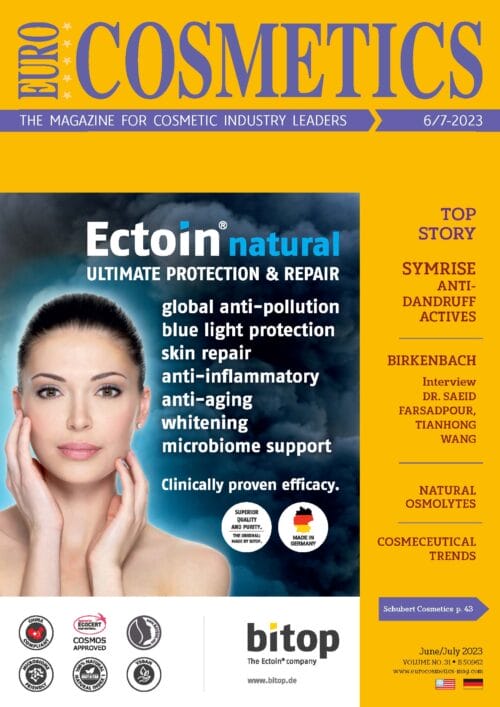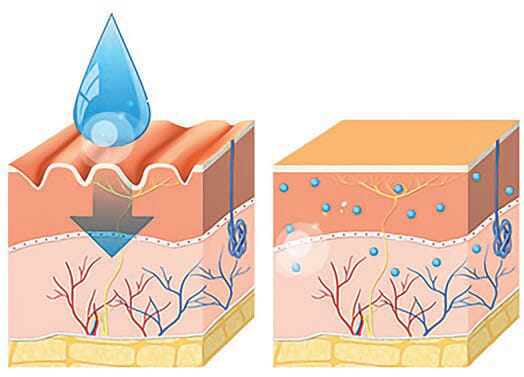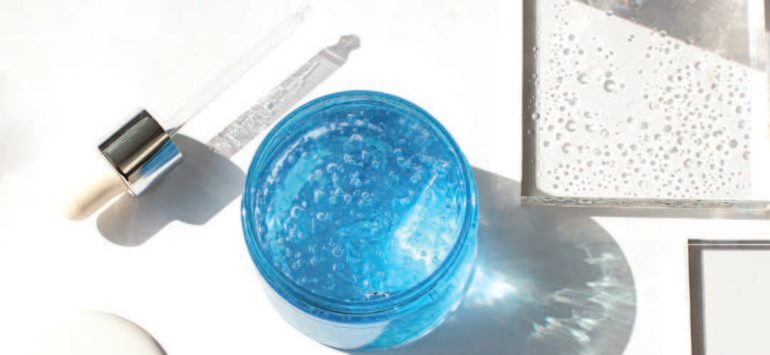
Author’s Note:
What is this multi-faceted active ingredient we talk so much about for the skin’s youthful appearance? This natural element of the epidermis sees its stock gradually diminish over time, reaching only 50% of its capital at the age of 50, causing premature ageing of the skin. Why is it useful for us to renew the hyaluronic acid in our tissues? How can you incorporate it into your nutricosmetic solutions?
Hyaluronic acid in the body
It is an essential constituent of many tissues and physiological fluids. For example, the dermis contains half of the human body’s total hyaluronic acid. Isolated for the first time in 1934 by Meyer and Palmer, this element was long considered to be a filling material of little interest, but it has now been shown to play a decisive role in many physiological mechanisms:
– It is one of the main constituents of the extracellular matrix of connective tissue, where it helps to maintain hydration thanks to its great capacity to retain water.
– It influences many important cellular processes: activation of macrophages and granulocytes, protection, proliferation, differentiation and cell migration.
Production turning to biotechnology
The first industrial productions were carried out by extraction from the cock’s crest.
In recent years, production has turned to biotechnology, and much of this acid is now produced by fermentation. These biotechnologies make it possible to avoid using animal derivatives in cosmetics and pharmaceutical products.
Certain micro-organisms, in particular Lancefield streptococci A and C, are a source of hyaluronic acid. These lactic bacteria have the capacity to produce this active ingredient, which is an essential constituent of their capsule. This extracellular production is in fact a natural defence mechanism against specific conditions.
Whatever its origin, the chemical structure of the polymer is the same (identical molecule). The ability of hyaluronic acid to retain water leads us to take a closer look at the phenomenon of hydration and its role.

Moisturising the skin orally
A first approach to deeply moisturising the skin is to take hyaluronic acid in the form of capsules, tablets or drinkable ampoules. But how does this active ingredient work within our various skin layers? What impact does it have on the ageing of our skin?
Water retention in the dermis
The special structure of hyaluronic acid enables it to retain more water than most other natural or synthetic polymers. A 2% aqueous solution of this pure acid retains the remaining 98% water, giving the appearance of a gel. However, it is not a gel. This property is very specific to hyaluronic acid, and enables it to form a viscoelastic network (gel-like structure).
One of the most important roles of hyaluronic acid in the skin is to maintain hydration by retaining water in the extracellular matrix. Its polymeric network acts like a “molecular sponge”.
Hyaluronic acid in the epidermis
Although the dermis contains most of the skin’s hyaluronic acid, epidermal cells also have the capacity to produce it. The water retained by hyaluronic acid both in the dermis and in the vital layers of the epidermis is essential for maintaining hydration.
Hyaluronic acid and ageing
The ageing of the skin, particularly after the age of 50, is accompanied by changes in its macromolecular components, leading to radical changes in the viscoelastic properties of the extracellular matrix of the dermis. In particular, the hyaluronic acid present in the epidermis gradually disappears. In the dermis, recent studies have shown that the major change is an increase in the bonds between the tissues and the acid, which becomes less and less extractable, and loses its ability to retain water and maintain hydration.

As a result, it would appear that age-related changes to the skin – loss of elasticity and suppleness, wrinkles, dryness – are linked to these changes to the hyaluronic acid network in the dermis.
The aim of taking this product orally is to bring collagen to the tissues by creating a mechanical and biological effect. The presence of collagen is recognized by the skin cells (fibroblasts), which then begin the process of synthesis of collagen and natural hyaluronic acid.
Moisturizing the skin throughout cosmetics
Choosing to incorporate hyaluronic acid into your beauty routine through cosmetics is a second approach. Whether in the form of day or night creams, serums, masks or even patches, the cutaneous application of this active ingredient helps to hydrate the skin, prevent and reduce the appearance of wrinkles, and more importantly, repair the skin’s structure.
High molecular weight hyaluronic acid solutions form non-occlusive viscoelastic films when applied to the skin, regulating water perspiration. These films retain water in the same way as acid in the extracellular matrix of connective tissue. They also protect the skin from external aggression, which could damage the epidermal lipid barrier and lead to significant desquamation of the stratum corneum.
Studies of different moisturizers show that the most effective polymer for maintaining hydration should have the following properties:
– A high molecular weight;
– A high affinity for water;
– A heterogeneous structure to form a supple, flexible film on the skin.
Hyaluronic acid meets all these criteria, making it an ideal moisturizer.
Hyaluronic acid: multiple applications for the skin
In conclusion, this multi-faceted molecule can be used in cosmetic products, food supplements and medical devices to fill wrinkles, in different grades depending on the application. This active ingredient is a perfect illustration of the concept of “nutricosmetics” or “beauty in&out”. Combining an oral and cutaneous intake would increase its long-term effectiveness on our tissues.



